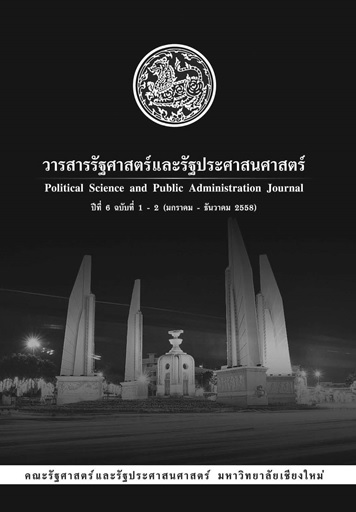Migration Selection Policy of Healthcare Labour from Southeast Asian Countries to Japan under Economic Partnership Agreements
Main Article Content
บทคัดย่อ
Japan has signed the Economic Partnership Agreements (EPA) regarding the collaboration on movement of natural in persons (MNPs) since 2006 to receive nurses and caregivers from countries in Southeast Asia. It is considered the early official scheme for Japan to accept foreign healthcare workers through the government to government arrangements. The implication of the policy reveals the significance of healthcare context as well as the state’s policy towards the care labour mobility in the region reflecting from receiving and sending countries. This paper discusses the implication of labour selectivity applied through the immigration policy of accepting foreign healthcare workers. The debate focuses on the notion of discriminating professionalism from the host countries like Japan towards the labour sending countries such as Indonesia, Philippines, Thailand and Vietnam. The paper explores the discourse of international division of reproductive labour as well as examines politics of policy-oriented towards managing international migration of healthcare labour.
Article Details
- เนื้อหาและข้อมูลที่ลงตีพิมพ์ในวารสารรัฐศาสตร์และรัฐประศาสนศาสตร์ถือเป็นข้อคิดเห็นและความรับผิดชอบของผู้เขียนบทความโดยตรง ซึ่งกองบรรณาธิการวารสารรัฐศาสตร์และรัฐประศาสนศาสตร์ ไม่จำเป็นต้องเห็นด้วย หรือร่วมรับผิดชอบใดๆ
- บทความและข้อมูล ที่ได้รับการตีพิมพ์ในวารสารรัฐศาสตร์และรัฐประศาสนศาสตร์ ถือเป็นลิขสิทธิ์ของวารสาร หากบุคคลหรือหน่วยงานใดต้องการนำข้อมูลไปใช้ประโยชน์ในทางวิชาการ ขอให้อ้างอิงแหล่งที่มาด้วย
เอกสารอ้างอิง
Aiken, Linda. (2007). U.S. Nurse Labour Market Dynamics are Key to Global Nurse Sufficiency. Health Service Research. 42(3), pp. 1299-1320.
Ball, Rochelle E. (2004). Divergent Development, Racialised Rights: Globalised Labour Markets and the Trade of Nurses-The Case of the Philippines. Women’s Studies International Forum. 27(2004), pp. 119-133.
Bush, Barbara. & Sochalski, Julie. (2007). International Nurse Migration: Lessons from the Philippines. Policy, Politics, & Nursing Practice. 8(1), pp. 37-46.
Care Workers’ Support Centre Foundation (Kaigo Rodo Antei Senta). (2009). Shitsumon Koumoku [Questionnaires]. Unpublished.
Fukuda, Takahiro. (2008). EPAs Clearing Way for Foreign Caregivers [online]. [Accessed 26 May 2008]. Available from: http://search.japantimes.co.jp/print/nn20080521f1html.
Gabriel, Christina. (2008). A ‘Healthy’ trade? NAFTA, labour mobility and Canadian Nurses, in Gabriel, Christina and Pellerin, Hélène (eds.). Governing International Labour Migration: Current Issues, Challenges and Dilemmas. Abingdon, Oxon: Routledge, pp. 112-127.
Glenn, Everlyn N. (1992). From Servitude to Service Work: Historical Continuities in the Racial Division of Paid Reproductive Labor. Signs. 18(1), pp. 1-43.
Inoue, Jun. (2010). Migration of Nurses in the EU, the UK, and Japan: Regulatory Bodies and Push-Pull Factors in the International Mobility of Skilled Practitioners [online]. [Accessed 7 June 2010]. Available from: http://hermes-ir.lib.hit-u.ac.jp/rs/bitstream/ 10086/18312/1/DP526.pdf.
International Organisation for Migration (IOM). (2004). A Background Paper. In: Crossborder Movement of Natural Persons: Economic Partnership Agreement and Acceptance of Foreign Workers, 27 July 2004, Tokyo. n/a, pp. 1-26.
Iredale, Robyn. (2001). The Migration of Professionals: Theories and Typologies. International Migration. 39 (5), pp. 7-26.
Iredale, Robyn. (2005). Gender, immigration policies and accreditation: valuing the skills of professional women migrants. Geoforum. 36(2), pp. 155-166.
Kingma, Mireille. (2006). New Challenges, Emerging Trends, and Issues in Regulation of Migrating Nurses. Policy Politics Nursing Practice. 7(3), pp. 26S-33S.
Kline, Donna S. (2003). Push and Pull Factors in International Nurse Migration. Journal of Nursing Scholarship. 35(2), pp. 107-111.
Lan, Pei-Chia. (2008). New Global Politics of Reproductive Labor: Gendered Labor and Marriage Migration. Sociology Compass. 2(6), pp. 1801-1815.
Ministry of Foreign Affairs, Japan (MOFA). (2006). Annex 8 referred to in Chapter 9 Specific Commitments for the Movement of Natural Persons [online]. [Accessed 10 May 2008]. Available from: http://www.mofa.go.jp/region/asiapaci/philippine/epa0609/annex8.pdf.
Ministry of Foreign Affairs, Japan (MOFA). (2007). Annex 10 referred to in Chapter 7 Specific Commitments for the Movement of Natural Persons [online]. [Accessed 15 May 2008]. Available from: http://www.mofa.go.jp/region/asiapaci/indonesia/epa0708/annex10.pdf.
Ministry of Foreign Affairs, Thailand (MFA). (2009a). Report of Public Debate on JTEPA. Bangkok: Ministry of Foreign Affairs, Thailand.
Ministry of Health, Labour and Welfare, Japan (MHLW). (2009a). Acceptance of Indonesian Candidates for “Kangoshi” and “Kaigofukushishi” based on JIEPA. Unpublished.
144
Ministry of Health, Labour and Welfare, Japan (MHLW). (2009b). Chapter 5 Creating a Welfare Society Where Elderly can be Active and Comfortable [online]. [Accessed 3 February 2011]. Available from: http://www.mhlw.go.jp/english/wp/wp-hw3/dl/Part02-05.pdf.
Ministry of Health, Labour and Welfare, Japan (MHLW). (2009c). The Number of the Accepting Institutions and the Matched Candidates in 2009 under JPEPA. Unpublished.
Nursing and Midwifery Council, UK (NMC). (2010a). Registering as Nurses or Midwife in the United Kingdom [online]. [Accessed 3 August 2010]. Available from: http://www.nmc-uk.org/Documents/Registration/Registration%20information%20trained %20outside%20Europe.pdf.
Nursing and Midwifery Council, UK (NMC). (2010b). Trained in Europe: Information for Nurses and Midwives Who trained in an EU or EEA Member State [online]. [Accessed 3 August 2010]. Available from: http://www.nmc-uk.org/Registration/Joining-the-register/Trained-in-the-EU-or-EEA/.
Onuki, Hironori. (2009). Care, Social (Re)production and Global Labour Migration: Japan’s Special Gift toward ‘Innately Gifted’ Filipino Workers. New Political Economy. 14(4), pp. 489-516.
Panao, Alicor L. (2007). Japan Trade Pact may just spell False Hopes for Filipino Health Care Workers [online]. [Accessed 25 May 2008]. Available from: http://www.thaifta.com/ThaiFTA/NewsFTA/tabid/ 67/ctl/Details/mid/559/ItemID/2772/.
Philippine Overseas Employment Administration (POEA). (2009). Memorandum of Understanding (MOU) between the Philippine Overseas Employment Administration and the Japan International Corporation of Welfare Services on the Deployment and Acceptance of Filipino Candidates for “Kangoshi”, Filipino Candidates for “Kaigofukushishi’, Filipino “Kangoshi”, and Filipino “Kaigofukushishi” [online]. [Accessed 24 May 2010]. Available from: http://www.poea.gov.ph/jpepa/mou-jpepa.pdf.
Professional Connections. (2010). Application Process [online]. [Accessed 5 August 2010] Available from: http://www.nursinginsaudi.net.
Reynolds, Isabel. (2008). Ageing Japan to get First Foreign Nurses-Report [online]. [Accessed 26 May 2008]. Available from: http://www.bilaterals.org/article-print.php3?id_article= 12140.
145
Smith, Pam & Mackintosh, Maureen. (2007). Profession, Market and Class: Nurse migration and the Remarking of Division and Disadvantage. Journal of Clinical Nursing. 16(2007), pp. 2213-2220.
Tumulty, Gail. (2001). Professional Development of Nursing in Saudi Arabia. Journal of Nursing Scholarship. 33(3), pp, 285-290.


